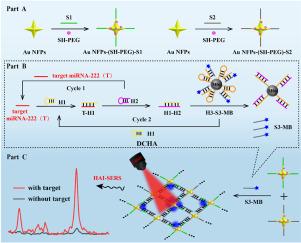Au NFPs Hotspot Aggregation-induced Surface-Enhanced Raman Scattering with DCHA as effective signal amplification for the Ultrasensitive detection of liver cancer markers
IF 6
2区 化学
Q1 CHEMISTRY, ANALYTICAL
引用次数: 0
Abstract
Background
The development of highly sensitive methods for detecting the liver cancer biomarker microRNA-222 (miRNA-222) is critical for early diagnosis. While surface-enhanced Raman scattering (SERS) technology holds potential, existing gold nanostructures like nanobipyramids (Au NBPs) and nanoarrows (GNAs) offer limited enhancement due to their small number of sharp corners. Furthermore, efficient signal amplification strategies are required for ultrasensitive detection. Nucleic acid amplification strategies such as HCR and CHA suffer from issues like low conversion efficiency and long reaction times, resulting in limited amplification capability.Results
In this study, a surface-enhanced Raman scattering (SERS) biosensor was constructed by Gold Nano Four-Pointed Stars (Au NFPs) hotspot aggregation-induced SERS (HAI-SERS) as enhancement substrate with use of a dual catalyst hairpin assembly (DCHA) as signal amplification for ultrasensitive detection of the target microRNA-222 (miRNA-222) related to liver cancer. In the aid of the DCHA as effective signal amplification, a minute quantity of target miRNA-222 can be converted into a substantial amount of output DNA modified with Raman molecular MB to form DNA net composition containing a mass of Au NFPs as enhancement substrate, which realized rapid and ultra-sensitive detection of miRNA-222 with a low limit of detection (LOD) of 0.33 fM, and the method was also effective in detecting miRNA-222 in HCCLM3 and MHCC-97L cell lysates.Significance
This strategy constructs a SERS biosensor for the ultrasensitive detection of liver cancer-associated miRNA-222. This biosensor utilizes DCHA as a signal amplifier and employs DNA to assemble Au NFPs, forming a hotspot aggregation-induced SERS (HAI-SERS) platform. This work proposes a Raman enhancement strategy based on the induction of Au NFPs aggregation hotspots, which can achieve highly sensitive detection of biomarkers and has broad application potential in early disease diagnosis.

Au NFPs热点聚集诱导的表面增强拉曼散射与DCHA作为有效的信号放大用于肝癌标志物的超灵敏检测
开发高灵敏度检测肝癌生物标志物microRNA-222 (miRNA-222)的方法对肝癌的早期诊断至关重要。虽然表面增强拉曼散射(SERS)技术具有潜力,但现有的金纳米结构,如纳米金字塔(Au nbp)和纳米箭头(GNAs),由于它们的尖角数量少,增强效果有限。此外,超灵敏检测需要有效的信号放大策略。HCR、CHA等核酸扩增策略存在转化效率低、反应时间长等问题,扩增能力有限。结果本研究以金纳米四点星(Au NFPs)热点聚集诱导SERS (HAI-SERS)为增强底物,利用双催化剂发夹组件(DCHA)作为信号放大,构建了表面增强拉曼散射(SERS)生物传感器,用于超灵敏检测肝癌相关靶microRNA-222 (miRNA-222)。援助的DCHA作为有效的信号放大,一分钟目标microrna - 222的数量可以转化为大量的输出DNA与拉曼分子MB修改形成DNA净成分包含大量的非盟国家增强衬底,实现快速和敏感的探测下限的microrna - 222检测(LOD) 0.33调频,和方法也有效地检测microrna - 222 HCCLM3和mhcc - 97 l细胞溶解产物。意义本策略构建了一种超灵敏检测肝癌相关miRNA-222的SERS生物传感器。该生物传感器利用DCHA作为信号放大器,利用DNA组装Au NFPs,形成热点聚集诱导SERS (hotspot aggregation-induced SERS, HAI-SERS)平台。本研究提出了一种基于Au nfp聚集热点诱导的拉曼增强策略,可以实现对生物标志物的高灵敏度检测,在疾病早期诊断中具有广泛的应用潜力。
本文章由计算机程序翻译,如有差异,请以英文原文为准。
求助全文
约1分钟内获得全文
求助全文
来源期刊

Analytica Chimica Acta
化学-分析化学
CiteScore
10.40
自引率
6.50%
发文量
1081
审稿时长
38 days
期刊介绍:
Analytica Chimica Acta has an open access mirror journal Analytica Chimica Acta: X, sharing the same aims and scope, editorial team, submission system and rigorous peer review.
Analytica Chimica Acta provides a forum for the rapid publication of original research, and critical, comprehensive reviews dealing with all aspects of fundamental and applied modern analytical chemistry. The journal welcomes the submission of research papers which report studies concerning the development of new and significant analytical methodologies. In determining the suitability of submitted articles for publication, particular scrutiny will be placed on the degree of novelty and impact of the research and the extent to which it adds to the existing body of knowledge in analytical chemistry.
 求助内容:
求助内容: 应助结果提醒方式:
应助结果提醒方式:


